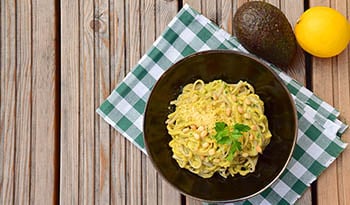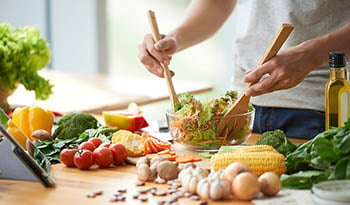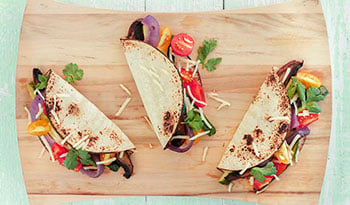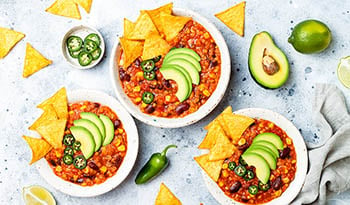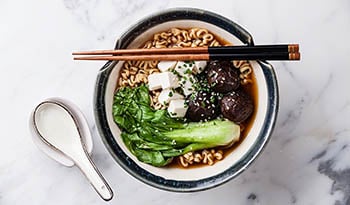Як з'їсти добову норму білка, будучи вегетаріанцем
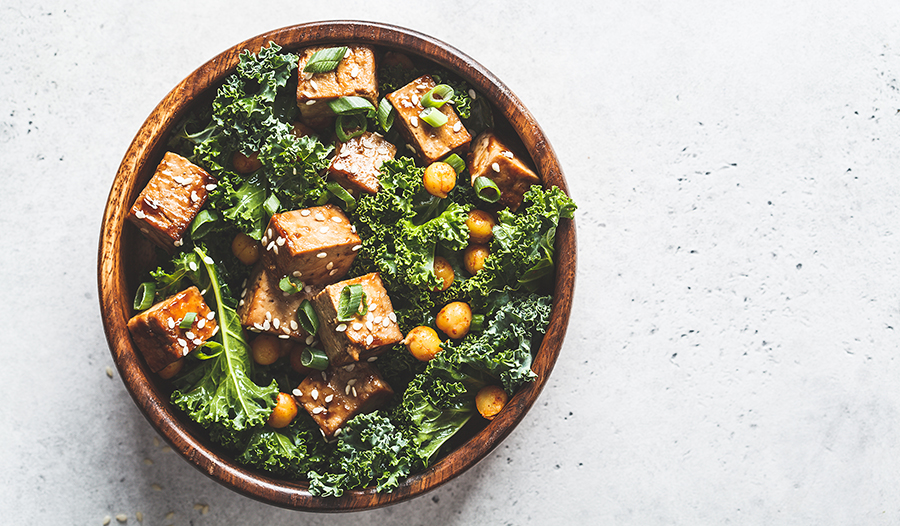
Перше питання, яке люди зазвичай ставлять вегетаріанцям чи веганам, - "Де ви берете білок?" Поширеною помилкою є думка, що білок можна отримати лише з м'яса. Хоча м'ясо містить багато білка, воно не повинно затьмарювати його рослинні аналоги.
Дотримання безм'ясної дієти не означає, що ви не отримаєте рекомендовану добову норму білка. Бобові, горіхита насіння - чудові безм'ясні джерела білка, які забезпечують достатнє його споживання дорослими, що дотримуються вегетаріанської та веганської дієт.
4 типи вегетаріанців
Існує багато різних типів дієт, які виключають м'ясо. Нижче наведено найпоширеніші безм'ясні дієти.
- Лакто-ово-вегетаріанці - найпоширеніший тип вегетаріанців, під яким зазвичай розуміють просто вегетаріанство. Ця модель харчування виключає яловичину, свинину, птицю, рибу, молюсків і м'ясо тварин у будь-якому вигляді, але включає яйця і молочні продукти. Слово "лакто" походить від латинського "молоко", а "ово" означає яйце.
- Лакто-вегетаріанська дієта виключає м'ясо, рибу, птицю та яйця, але включає молочні продукти, такі як молоко та сир.
- Ово-вегетаріанські дієти уникають м'яса, птиці, морепродуктів і молочних продуктів, але включають яйця.
- Веганська дієта виключає всі продукти тваринного походження, включаючи м'ясо, молочні продукти, яйця та мед.
Чому білок важливий?
Білки складаються з амінокислот і є важливою частиною всіх ваших клітин. Організм використовує білок для побудови та відновлення тканин. Він також відповідає за побудову кісток, м'язів, хрящів, шкіри та крові. Білки також використовуються для виробництва ферментів і гормонів в організмі.
При нестачі відповідної кількості білка протягом тривалого періоду часу ви ризикуєте втратити ці ключові функції. Важливо також відзначити, що дефіцит білка зустрічається досить рідко, і легко отримати весь необхідний білок, не вживаючи м'яса.
Скільки білка мені потрібно?
DRI (Dietary Reference Intake) для білка становить 0,8 грама білка на кілограм маси тіла або 0,36 грама на фунт. Наприклад, якщо ви важите 150 фунтів, вам потрібно приблизно 54 г білка на день. Або ж ви можете прагнути до того, щоб 10-15% вашого щоденного споживання калорій припадало на білки.
Кількість, яка вам потрібна щодня, також залежить від вашого віку, статі та рівня фізичної активності. Будь-який з цих факторів може збільшити вашу добову потребу в білку. Найкраще працювати з зареєстрованим дієтологом, якщо вас турбує адекватне споживання білка.
Які існують вегетаріанські джерела білка?
Вегетаріанські білки можуть включати всі боби: квасолю, боби пінто, чорну квасолю, нут, колотий горох, сочевицю та сою, але не обмежуються ними. Ці продукти є чудовими джерелами рослинного білка, а також містять інші поживні речовини, такі як залізо та цинк. . Вони схожі на тваринні білки і можуть вважатися частиною білкової або рослинної харчової групи відповідно до USDA (Міністерство сільського господарства США). Для м'ясоїдів боби та бобові вважаються рослинними джерелами через вміст у них харчових волокон ,, фолатівта калію. .
Більшість вегетаріанських білків, за винятком сої та кіноане є повноцінними білками. Це означає, що вони мають лише деякі з дев'яти незамінних амінокислот. Не хвилюйтеся: неповноцінні білки можна поєднувати разом протягом дня, щоб отримати всі необхідні поживні речовини.
Приклади вегетаріанського білка
- Сейтан - найщільніший за вмістом білка з усіх вегетаріанських білків. Його виготовляють з глютену, основного білка в пшениці. Він має приблизно 25 грамів білка на 3,5 унції (100 грамів), що робить його найбільш щільним за вмістом білка з усіх вегетаріанських білків). Сейтан - один з найпопулярніших м'ясних муляжів через його близьку схожість до м'яса за текстурою та виглядом.
- Квасоля мунг важко знайти в магазині, але легко замовити онлайн. Ці бобові недооцінюють, але в одній чашці вареної квасолі міститься 14 грамів білка. Квасоля мунг зазвичай вживають у салатах, супах та смаженій картоплі.
- Тофу, темпе та едамаме - приклади повноцінного вегетаріанського білка. Тофу виготовляють шляхом пресування соєвих бобів, подібно до того, як роблять сир. Темпе виготовляється з ферментованих соєвих бобів, які пресуються разом. Кожен з них містить приблизно 10-19 грамів білка на 3,5 унції (100 грамів). Тофу і темпе популярні для приготування страв, оскільки вони дуже добре вбирають смаки інших продуктів. Готуючи тофу, обов'язково спочатку відіжміть воду; відваріть або приготуйте темпе на пару, щоб він мав менш гіркий смак.
- Сочевиця буває різних сортів, але найпопулярнішими є зелена та червона. Вони не тільки популярні, але й прості у приготуванні. Просто додайте сочевиці у воду і відваріть до м'якості. Одна чашка вареної сочевиці містить близько 18 грамів вегетаріанського білка.
- Харчові дріжджі- іноді їх називають "нуч" - ще одне повноцінне вегетаріанське джерело білка. Цей продукт можна додавати до багатьох страв, як у вигляді суміші, так і посипаючи зверху. Харчові дріжджі можуть додати стравам додатковий білковий заряд і горіховий або сирний смак, вони забезпечують 3 грами білка на столову ложку. Харчові дріжджі містять не тільки білок, але й вітаміни групи В, зокрема B12.
- Насіння конопель є чудовим доповненням до смузі та використовується як начинка для салатів. Насіння конопель містить 10 грамів білка на унцію - на 50% більше, ніж насіння чіа та насіння льонуякі також є вегетаріанськими білками. Це насіння не тільки багате на білок, але й має оптимальний баланс омега-3 та омега-6 жирних кислот.
Якщо у вас обмаль часу, їжа швидкого приготування або їжа з невеликою кількістю інгредієнтів може допомогти вам задовольнити вегетаріанську потребу в білках на день. Спробуйте запастися рослинними протеїновими порошками, мюслі або снеками на основі бобів.
Високобілковий денний раціон для вегетаріанців
Сніданок:
- 1 склянка вівсянки (6 грамів білка)
- 8 унцій соєвого йогурту (9 грамів)
- 1⁄2 склянки полуниці (0 грамів)
Обід:
- 2 скибочки цільнозернового хліба (7 грамів)
- 2 ст.л. хумусу (5 грамів).
- 1 склянка вареної чорної квасолі (14 грамів).
- 1 склянка шпинату (1 грам).
Вечеря:
- 5 унцій твердого тофу (12 грамів).
- 1 склянка вареної броколі (4 грами).
- 2 ст.л. харчових дріжджів (6 грам)
Перекус:
- 2 ст.л. арахісової пасти (8 грам)
- 1 яблуко (0 грамів)
Загальна кількість білка: 72 грами
*Обов'язково додайте додаткові групи продуктів, щоб створити збалансовану тарілку. До цього зразкового плану харчування слід додати всі групи продуктів, щоб забезпечити задоволення всіх інших потреб у поживних речовинах - це лише приклад того, як включити більше білка у свій день.
Користь для здоров'я від вживання більшої кількості вегетаріанських білків
Рослинно-орієнтовані дієти стають дедалі популярнішими, що, можливо, і добре. Доведено, що людина, яка дотримується вегетаріанської дієти, має знижений ризик хронічних захворювань, таких як діабет і хвороби серця. Ця група населення також зазвичай має нижчий рівень холестерину ліпопротеїнів низької щільності (ЛПНЩ або поганий холестерин) і нижчий кров'яний тиск. Користь для здоров'я, ймовірно, пов'язана з меншим споживанням насичених жирів і холестерину та більшим споживанням фруктів, овочів, цільного зерна, горіхів, соєвих продуктів, клітковини та антиоксидантів у вегетаріанському раціоні.
Екологічні переваги вибору білків рослинного походження
Кожен вибір їжі, який ми робимо, впливає на світ навколо нас. Тваринництво є основним джерелом парникових газів. Виробництво продуктів тваринного походження, особливо червоного м'яса, зокрема яловичини, баранини та козлятини, спричиняє більше викидів парникових газів, ніж виробництво білків рослинного походження. Ці білки тваринного походження не лише спричиняють більше викидів, але й створюють великий попит на природні ресурси, що сприяє вирубці лісів, вимиранню видів та забрудненню прісної води. Вибір продуктів харчування має безпосередній вплив не лише на ваше здоров'я, але й на здоров'я Землі.
5 порад для початківців вегетаріанців
Якщо ви тільки починаєте вживати вегетаріанські білки замість м'ясних, скористайтеся цими порадами, які допоможуть вам легко перейти на безм'ясне харчування.
- З'їдайте одну пісну страву протягом тижня.
- Робіть заміни у своїх улюблених рецептах: наприклад, замініть яловичий фарш зеленою сочевицею, текстурованим соєвим білком або квасолею.
- Знайдіть вегетаріанську або веганську кулінарну книгу або блог. Це чудові місця для пошуку нових рецептів або натхнення.
- Знайдіть систему підтримки або друга-однодумця. Наявність когось, хто має ті ж ідеали або моральні зобов'язання щодо їжі, може зробити вегетаріанство легким і безтурботним.
- Зверніться до зареєстрованого дієтолога, який допоможе вам переконатися, що ви задовольняєте свої щоденні потреби в макро- та мікроелементах.
Джерела:
- Berryman CE, Lieberman HR, Fulgoni VL 3rd, Pasiakos SM. Тенденції споживання білка та відповідність дієтичним нормам у США: аналіз Національного дослідження здоров'я та харчування, 2001-2014 рр. Am J Clin Nutr. 2018;108(2):405-413. doi:10.1093/ajcn/nqy088
- Callaway, J.C. Конопляне насіння як харчовий ресурс: Огляд. Euphytica 140, 65-72 (2004). https://doi.org/10.1007/s10681-004-4811-6
- Маріотті, Ф., Гарднер, К. Д. (2019). Харчові білки та амінокислоти у вегетаріанській дієті - огляд. Nutrients, 11(11), 2661. https://doi.org/10.3390/nu11112661
- Позиція Американської дієтичної асоціації: Вегетаріанські дієти. (2009, 1 липня). Журнал Академії харчування та дієтології. https://jandonline.org/article/S0002-8223(09)00700-7/fulltext#articleInformation
- Вейт, Р., М. Беверідж, Р. Брумметт, С. Кастін, Н. Чайяваннакарн, С. Каушик, Р. Мунгкунг, С. Навапакпілай та М. Філліпс. 2014. "Підвищення продуктивності та екологічних показників аквакультури". Робочий документ, частина 5 дослідження "Створення сталого продовольчого майбутнього". Вашингтон, округ Колумбія: Інститут світових ресурсів.
ВІДМОВА ВІД ВІДПОВІДАЛЬНОСТІ:Інформація, що міститься в Центрі здоров'я, не призначена для встановлення діагнозу...













































































 Зміст
Зміст



